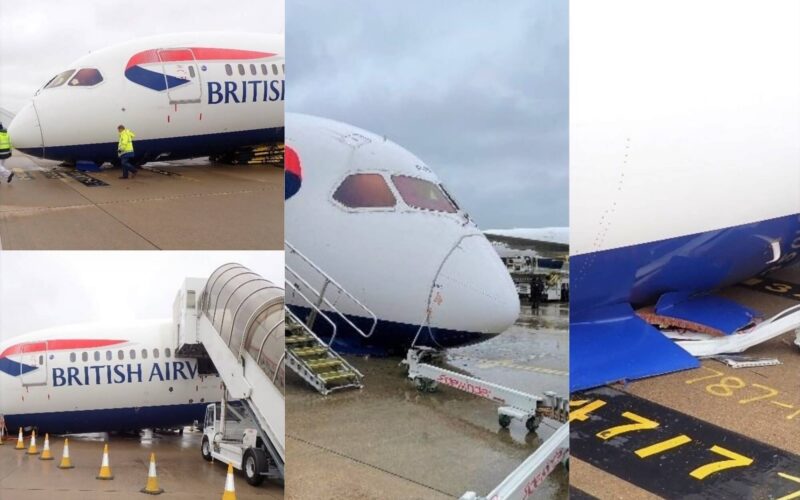An investigation has found that a British Airways plane suffered “significant damage” when its nose struck the ground during an incident at Heathrow Airport.
The Air Accidents Investigation Branch (AAIB) said the incident occurred while the Boeing 787 Dreamliner jet, registration G-ZBJB, was parked on a stand at London Heathrow Airport (LHR) on June 18, 2021, causing damage to the front lower side of the plane’s fuselage. This resulted in minor injuries to the co-pilot and a member of the cargo loading crew.
The AAIB detailed the reason behind the incident in its final report.
What happened to the British Airways Dreamliner?
The 9.4-year-old plane, which was parked on a stand in Terminal 5 at LHR airport, was scheduled to perform a cargo flight BA906 between London (LHR) and Frankfurt (FRA) in Germany.
While the pilots were preparing the plane for departure, the ground maintenance team was working to address three fault messages associated with the Nose Landing Gear (NLG) doors. When the captain asked the Licensed Aircraft Engineer (LAE) how long it would take to fix the issues, he was informed that the maintenance tasks could be completed in around 40 minutes. The captain then performed the aircraft walk around check but did not witness any abnormalities, and a team of loaders continued to load freight onto the aircraft.
When the First Officer was moving through his pre-departure checks, he had a minor interaction with the LAE as both specialists were focused on their tasks. Shortly after the First Officer received the flight departure clearance, the LAE raised the gear level to the ‘up’ position. The pilot later recalled hearing the aircraft gear system actuated. It was at that moment that the plane’s nose hit the ground.
How does a downlock pin prevent aircraft from landing gear retraction?
The NLG on a Boeing 787-8 Dreamliners consists of a shock strut, an extension and retraction mechanism, two unbraked wheels, a torque link, and a nosewheel steering system.
The NLG extension and retraction mechanism features a hydraulic NLG lock actuator, which can lock and unlock a lock link assembly. This mechanism prevents the landing gear from retracting or extending when it is selected in an over-center position.
When the NLG needs to be retracted, hydraulic pressure moves the lock link assembly away from the over-center position and unlocks the NLG, forcing it to retract into the wheel bay.
When the NLG area needs maintenance, the ground team usually prevents the lock link from moving away from the over-center position by installing a downlock pin.
“The pin is inserted in the downlock hole, aft of the lock link assembly apex pin bore hole, to fix the lock link in position and prevent retraction of the NLG even with hydraulic power applied and the landing gear selected to UP,” the AAIB report explained.
However, the pin used for a Boeing 787 Dreamliner has significant differences compared to those used on other Boeing planes.
“The downlock pin can be easily inserted into the apex pin bore hole. […] When it was fitted in this position it made a ‘click’ noise similar to the noise made when fitted into the correct downlock pin hole,” the AAIB report continued.
 AAIB
AAIB
What caused the incident?
Investigators found out that the NLG downlock pin had inadvertently been installed in the wrong place. Instead of placing it in the downlock pin hole, the G-ZBJB engineering team placed it in the downlock link assembly apex pin bore. According to the AAIB, this may have been because the two holes are located near one other.
“There were powerful auditory and tactile cues that could easily mislead someone to believe the pin was correctly inserted even when it wasn’t and there were no strong visual indications to distinguish between the correct and incorrect placements,” the report continued.
The procedure for how to install the downlock pin on a Dreamliner was detailed in a specific airworthiness directive (AD), which was made available for engineering teams in January 2020.
While each member of the ground maintenance team had confirmed they were familiar with the latest AD update, investigators found “there was no documented evidence” that the information had been fully considered.
Report results
When the nose of the British Airways Dreamliner struck the ground, both the First Officer, who was on the flight deck at the time, and a member of the cargo loading crew who was standing on a Unit Load Device (ULD) Loader next to the forward cargo door suffered minor injuries. In addition, the plane suffered “significant damage” to its lower front section, the report noted.
According to the AAIB, British Airways has reviewed its processes related to the assessment of ADs and safety bulletins in response to the incident and has ensured that ramp maintenance personnel are provided with access to Boeing technical data, documents, and manuals via their issued iPads.
The airline also has initiated a review of its Incident Response Manual.
“The operator [British Airways, ed.-] has introduced a new software application for tech news that has an improved interface including filtering and prioritization functions and requires each page of every article to be displayed before it can be signed,” the report concluded.

